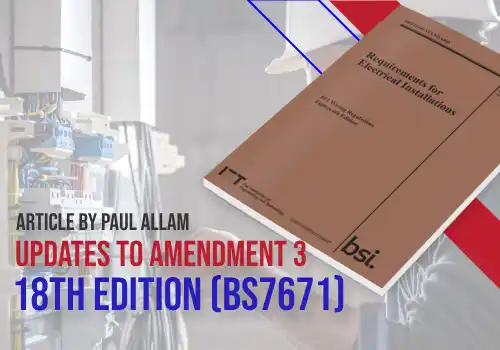

Amendment 3 to BS7671:2018, also referred to as the 18th Edition, marks a significant update aimed at enhancing electrical safety across all areas of installation and design. This amendment emphasizes the importance of the correct selection and installation of protective devices, which are essential for preventing electrical hazards in today’s increasingly complex and technologically advanced systems.
With the rise of renewable energy sources and more sophisticated electrical installations, the need for precise safety measures has grown. Amendment 3 addresses these challenges by updating the regulations to ensure that protective devices are both appropriately chosen and correctly installed, thereby safeguarding against potential risks and ensuring compliance with the latest safety standards.
The most significant change introduced by Amendment 3 is Regulation 530.3.201. This regulation addresses a critical aspect of modern electrical installations: the direction of power flow in protective devices. As renewable energy sources such as solar panels and battery storage systems become more common, the flow of electricity in installations is no longer strictly one-way. Power can now flow both from the grid to the load and from the load back to the grid.
This regulation is particularly relevant in installations involving renewable energy sources like solar panels, where electricity can flow back into the grid. By ensuring that protective devices are selected and installed based on the correct understanding of power flow, Amendment 3 helps prevent potential hazards and improves the overall efficiency of the electrical system.
One of the key concerns for many in the industry is how these new regulations will impact existing installations, particularly in the context of periodic inspections and Electrical Installation Condition Reports (EICRs).
The rise of solar panels and battery storage systems has fundamentally changed the landscape of electrical installations. These technologies allow for energy generation and storage on-site, which can then be fed back into the grid, creating a bidirectional flow of electricity. This shift is one of the primary reasons for the introduction of Regulation 530.3.201 in Amendment 3.
In systems with solar panels, for instance, during periods of low energy consumption and high solar generation, excess electricity is often exported back to the grid. Similarly, battery storage systems store energy during off-peak times or when generation exceeds demand, which can then be used later or fed back into the grid. Both scenarios involve a reversal of the typical flow of electricity, which necessitates the correct selection of protective devices to handle this bidirectional flow safely.
Ensuring compliance with Amendment 3 means paying close attention to the protective devices used in these installations. The right devices must be selected to ensure that they can handle power flowing in both directions without compromising safety or efficiency. This is where bidirectional protective devices become crucial.
For those who already own the brown Amendment 2 BS7671 book, there’s no need to purchase a new edition to stay compliant with Amendment 3. The IET has provided a practical solution: the Amendment 3 “bolt-on pack.”
The Amendment 3 document is available as a free downloadable PDF from the IET website or here Here’s how you can update your existing book:
Another major concern for electricians and students alike is how Amendment 3 will affect the 18th Edition exams. Here’s what you need to know:
If you’re currently enrolled in a BS7671 exam course based on Amendment 2, there will be a brief crossover period during which you can complete your exams under the existing guidelines. After this period, all exams will be updated to reflect the changes introduced by Amendment 3.
If you already hold an 18th Edition wiring regulations certificate, there’s good news: you won’t need to retake the exam. Your existing knowledge, combined with the Amendment 3 document, will be sufficient to ensure compliance. However, it’s crucial that you familiarize yourself with the changes to stay current with the latest standards.
For those with a 17th Edition certificate, upgrading to the 18th Edition with Amendment 3 requires taking the full 60-question exam. Unfortunately, there’s no shorter refresher course available for this transition, so be prepared to invest time in studying the new material thoroughly.
To stay compliant with the latest standards, it’s essential to download your free copy of Amendment 3 from the IET website or here.
Amendment 3 of the 18th Edition represents a crucial update to the wiring regulations, particularly in an era where renewable energy sources like solar panels and battery storage systems are becoming more widespread. By understanding these changes, updating your reference materials, and preparing for any impact on your exams and inspections, you can ensure that you stay compliant and continue to excel in your electrical career.
I hope this guide has provided valuable insights into Amendment 3. For more information, resources, and updates, be sure to visit our article section and stay connected to the latest developments in the field. Together, we can continue to uphold the highest standards in electrical safety and quality.
Related Read
Paul has been a dedicated lecturer at Learn Trade Skills since 2022, bringing decades of expertise in both lecturing and the electrical industry to his students. With a rich background as an accomplished electrician, Paul combines practical experience with a deep passion for teaching, ensuring that his students not only grasp theoretical concepts but also gain the hands-on skills necessary for success in the field. Paul's commitment to education and his profession makes him a valued mentor and educator, continually inspiring the next generation of skilled tradespeople



© Copyright Learn Trade Skills 2025
“Lorem ipsum dolor sit amet, consectetur adipiscing elit. Ut pretium tristique purus nec consectetur. Nulla feugiat eget tellus aliquam scelerisque. Sed eget luctus enim, sed mattis enim. Lorem ipsum dolor sit amet, consectetur adipiscing elit. Ut pretium tristique purus nec consectetur. Nulla feugiat eget tellus aliquam scelerisque. Sed eget luctus enim, sed mattis enim.Nulla feugiat eget tellus aliquam scelerisque. Sed eget luctus enim, sed mattis enim. Lorem ipsum dolor sit amet, consectetur adipiscing elit. Ut pretium tristique purus nec consectetur. Nulla feugiat eget tellus aliquam scelerisque. Sed eget luctus enim, sed mattis enim.”
William Goss
Electrician course
11/11/2024